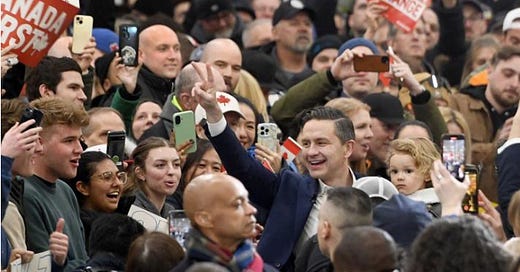Yes, Canada, size matters: campaign crowds tell a story too many have been dismissing
“In politics, you need both the quantitative and the qualitative to get a real pulse on the mood of the electorate”
Today we welcome guest columnist Evan Menzies, vice president of Crestview Strategy, who knows a thing or two about political campaigns)
Does crowd size matter this election?
The answer to that question, asked by the Globe and Mail’s Laura Stone to Pierre Poilievre, is yes, and its impact in this election and beyond shouldn’t be easily brushed off.
Horse race numbers are a daily sugar rush for political watchers, always looking for the next hint and smart commentary on trends.
They matter, and they’re relevant. But in politics, you need both the quantitative and the qualitative to get a real pulse on the mood of the electorate and the different voter demographics forming the coalitions that parties hope to cobble together to win power.
In the 21st century, the science of the political campaign rally has been refined and highly orchestrated in Canadian elections. The goal is visuals that demonstrate momentum and energy - a lasting image for the evening news cycle, designed to nurse a fear of missing out among fence-sitters and the unmotivated, nudging them off the couch and into the movement.
To do this, modern tour teams usually book venues that hold between 500–1,000 people, pack a riser behind the leader, and try to jam the room. Signs are pre-generated and handed out to supporters, often including volunteers from local campaigns. It’s common for campaign staff to plant themselves in the room to help lead the audience in booing and cheering at the appropriate lines.
Tours will usually hassle the local campaign on the ground to help drive numbers as high as possible - often to the irritation of organizers more concerned with door-knocking and talking to voters.
Outside of the energy and crowd surge for Justin Trudeau during the 2015 change election, this has more or less been the status quo for most parties for the past 25 years.
That hasn’t been the case for Pierre Poilievre.
It’s not just the size of the crowds; it’s the energy and organic passion that’s driving them. The Conservative campaign isn’t fretting about filling hotel rooms with 1,000 people; they’re fretting about finding venues that can accommodate everyone without crashing cell towers, overheating the space, or creating bathroom bottlenecks. Hard boxes to check when you’re filling out air hangars.
Families are showing up with homemade signs. Crowds organically lead chants of campaign slogans like it’s a home playoff game - before, during, and after every rally. No vocal cord is left unused during the kick-off O Canada, which reverberates like you’re at the Bell Centre during the first round of the playoffs - not at a political rally.
To the chagrin of some in the media still used to the traditional model of coverage, a whole new ecosystem has evolved around these rallies with pre- and post-event coverage.
Those familiar will know the name "Pleb the Reporter." His pre-rally livestreams have drawn an aggregate of 1.3 million views on YouTube alone and that doesn’t include the millions more from clips and screenshots circulating on other channels.
Just watch the energy in this clip from the Windsor rally.
His streams are just one piece. Alongside him, CPAC (which traditionally serves as the livestream hub for all parties) and Poilievre’s own YouTube channel, the numbers are startling.
Altogether, in aggregate, they’ve collected 3.3 million views on YouTube this campaign. That’s with zero paid promotion on a platform known to jealously guard its view metrics for advertisers. In contrast, Mark Carney’s CPAC numbers for rallies stood at just 160,000 as of April 12, with no other major stream indicators available on YouTube.
For the converted, these Poilievre rally events are a centre of community. They’re a powerful visual demonstration that supporters are not alone and that they long to stand shoulder to shoulder with one another.
While some may doubt the crowd size estimates - whether from the RCMP or the party - the aggregate attendance to date is above 50,000. Enough to fill a major football stadium.
This is entirely unprecedented in Conservative campaigns.
So what does it all mean?
First, keep an eye out for a hard-to-measure turnout surge. This is notoriously difficult to capture in public surveys, especially among traditional non-voters. Just like in the Conservative leadership race, Poilievre is pulling together and motivating a coalition not known for voting. Now, these voters are ready. They’re tuning into evening livestreams and waiting in line for hours just to hear him speak in person. Many would walk on broken glass to be there. That doesn’t guarantee a win on election day, but enthusiasm is premium currency in any campaign and the Poilievre Conservatives have it.
Second, Poilievre’s influence within Conservative politics won’t fade easily—win or lose.
A victory, surged by late-breaking momentum and backed by a cemented, enthusiastic base, will give Poilievre significant political capital. More importantly, it may act as a release valve for a large segment of the country alienated over the past ten years, helping to address deep-seated and often justified anxieties about the country’s direction.
But even in defeat, crowd size matters.
I’ve seen losing campaigns from the inside - you can feel the life drain from them quickly. It would be easy for Poilievre and his supporters to become deflated and alienated by endless polling showing the NDP and Bloc vote evaporating toward the Liberals. But so far, there are no glaring signs of collapse. In fact, momentum seems to be growing at these events.
If you’re in the Liberal war room, I can assure you there is no campaign member that truly feels motivated by the fact that their rallies or events have a fraction of the attention their opponent’s does. That’s why there has been such a big push to discredit these events by campaign handlers.
For those quietly posturing for a post-election position in the event of a loss, they should pay attention to how strong Poilievre’s appeal is across the conservative movement. This kind of energy is impossible to imitate. Win or lose, he will have led one of the largest and most galvanized groups of Conservative supporters in more than a generation.
The Carney Liberals won’t get to enjoy the glow of a new prime minister forever if they win on April 28. The Conservatives will need a united, energised movement to win in the future.
For all these reasons, the media and others shouldn’t dismiss the rallies’ impact this election. They matter.
They tell a story that too many are crudely dismissing by twinning it only to the daily horse race numbers.
We are witnessing a deeper political undercurrent.
Yes, crowd sizes do matter.
(Evan Menzies is a Vice President with Crestview Strategy and served as Director of Communications with Alberta’s United Conservative party and Wildrose party.)






I live on the opposite side of the country so hard to say just how bad the honking and disruption was, but for me the convoy was a revelation. One leader listened and brought them coffee and the other one( can’t bring myself call him a leader) called in the guns and ordered them gone. That’s when I knew which one was real and which one was pretend. The listener had my vote then and has my vote today. Go Poilievre!
I agree; by my estimation this race is way closer than it appears. The logic I'm operating under is based on both the underrepresentation of the young vote, and what I also assume is most likely a skewed sampling of predominantly the university-educated young vote.
I'm curious to know, quite frankly, how pollsters are connecting to the young...when generally-speaking nobody under the age of 40 answers their phones for any reason. This leads me to believe that their polling of the young consists of mainly those who've signed up to be polled...which would skew their data towards predominantly affluent university students and recent grads - who tend to lean left. When even that data shows majority Conservative support (which it does), to me I'm calculating a shadow Conservative support that could be as high as 60%. It wouldn't surprise me one bit.
On an anecdotal level, as a middle-aged adult who interacts with a lot of young adults. I don't know a single one that isn't Conservative...and these aren't rich kids...these are at-risk, on the edge of homelessness youths. They don't fear Trump ... he doesn't factor into the equation at all. They are desperate, feel they have no future ... and are sick and tired of seeing their friends die of fentanyl overdoses! While the Boomers have gotten rich ... their grandchildren are living through what can only be described as a genocide. Imagine being 20, and having lost at least a dozen friends to fentanyl overdoses.
In Victoria, where is live, I'm a member of a private Facebook page, whose only purpose is to document the passing of those on the streets. Every week, someone I know dies! The page is private to keep the callous insults of the wealthy out, so we can mourn the deaths of our friends.